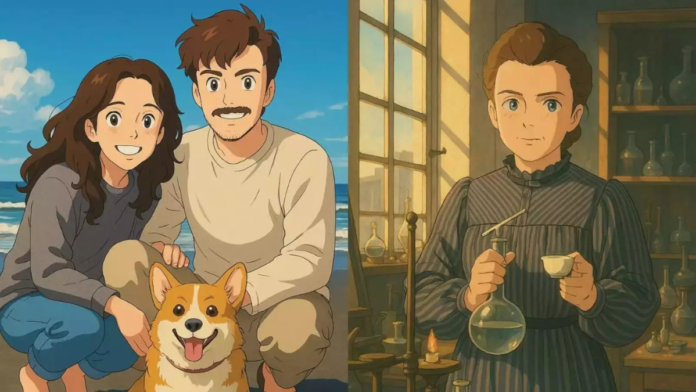The AI-generated Ghibli-style images have flooded social media, sparking a heated debate among artists and animation enthusiasts. The dreamy aesthetic of Studio Ghibli, with its expressive characters and painterly landscapes, has captivated audiences for decades. However, as artificial intelligence mimics this unique style, many artists feel uneasy about the rapid proliferation of AI-generated artwork.
AI image generators have advanced significantly in recent years, allowing users to create detailed illustrations in seconds. OpenAI’s latest tool, released on March 25, introduced new capabilities that enable users to replicate artistic styles with remarkable precision. Almost instantly, social media platforms became flooded with AI-generated portraits mimicking Ghibli’s iconic visuals. While casual users marveled at the accuracy, professional artists and animators questioned the implications.
For many, the charm of Studio Ghibli’s work lies in the human touch behind every frame. Hayao Miyazaki and his team have spent decades refining their craft, ensuring each detail reflects a personal and emotional depth. AI-generated images, no matter how visually appealing, lack that essence. “Just because it looks cute doesn’t mean it’s harmless,” remarked an illustrator who has spent years studying animation techniques. The widespread use of AI-generated art raises concerns about originality and artistic labor.
Several artists have expressed frustration over AI tools appropriating distinct styles without crediting or compensating the original creators. Unlike traditional digital art, where each brushstroke carries intent and effort, AI-generated works rely on pre-existing patterns and data to create imitations. This process sparks fears that automation may undermine human creativity, reducing it to a mere algorithmic function.
The debate extends beyond aesthetics into ethical and legal territories. Many question whether AI-generated images should be considered original artwork or derivative works that violate intellectual property rights. Some experts argue that training AI models on existing artistic styles without explicit consent from artists constitutes an ethical breach. Meanwhile, supporters of AI-generated art insist that these tools merely provide new ways for people to express themselves creatively.
Miyazaki himself has voiced strong opposition to artificial intelligence in animation. In a widely circulated interview, he described AI-generated content as an insult to human creativity, emphasizing that animation should come from deep emotional experiences rather than automated processes. His words have resonated with many artists who fear that AI threatens the integrity of hand-drawn animation.
Despite the controversy, AI-generated Ghibli-style images continue to trend, highlighting the growing accessibility of digital art tools. Some users argue that AI can serve as a complement to human creativity rather than a replacement. For instance, concept artists may use AI to generate rough sketches, which they can then refine manually. However, this perspective does little to ease concerns about the devaluation of traditional artistic skills.
As technology continues to evolve, the conversation around AI-generated art remains complex. The rise of AI tools forces the creative industry to reconsider what defines artistic authenticity and originality. While some artists explore ways to integrate AI into their workflows, others remain steadfast in preserving the human touch that makes art meaningful.
For now, the AI-Ghibli debate serves as a reminder that trends come and go, but true artistry endures. Whether AI-generated images become a lasting part of the artistic landscape or fade into novelty remains uncertain. What is clear, however, is that the discussion surrounding AI and creativity is far from over.
Artists who rely on traditional techniques worry that AI-generated images may flood the market, diminishing the value of hand-crafted work. Many fear that as AI tools become more accessible, clients and companies may prioritize cost-effective automation over hiring human artists. This shift could lead to fewer opportunities for emerging illustrators and animators who spend years mastering their craft. Some argue that art should not be about efficiency or speed but about personal expression and emotional depth—elements that AI struggles to replicate.
The rapid spread of AI-generated Ghibli-style images has also sparked discussions on how audiences perceive art. With AI producing near-instantaneous results, some viewers may no longer distinguish between human-made and machine-generated artwork. This blurring of lines raises questions about artistic appreciation—does an image lose its meaning if created in seconds rather than hours or days? If AI can perfectly mimic a beloved artistic style, does it devalue the work of those who have spent decades honing that style?
At the same time, AI’s role in animation continues to expand beyond static images. Some studios are experimenting with AI-assisted animation, using machine learning to speed up frame production and reduce labor costs. While this may increase efficiency, critics argue that such shortcuts could erode the unique qualities that define hand-drawn animation. Studio Ghibli’s films are celebrated for their meticulous details and organic movement—elements that many fear could be lost if AI-generated content becomes the norm.
Despite these concerns, AI-generated art has gained popularity among casual creators who see it as a tool for exploration rather than replacement. Some hobbyists, who may not have traditional drawing skills, use AI to bring their ideas to life. This accessibility has fueled a new wave of digital creativity, allowing more people to experiment with artistic expression. However, the question remains: if AI makes it possible for anyone to create visually stunning images without technical training, what does that mean for the future of skilled artists?
The debate over AI-generated Ghibli-style images highlights a broader conversation about the intersection of technology and creativity. While AI offers exciting possibilities, it also challenges long-standing ideas about artistic authenticity. As AI tools continue to evolve, the art world will have to navigate this shifting landscape, balancing innovation with the preservation of human-driven creativity.

